Tết in Vietnam: Traditional Tet snacks and food myths debunked
Celebrating Tết in Vietnam
Tết, or Lunar New Year, is an important holiday in Vietnam that marks the beginning of a new year. Think of Tết as the equivalent of Western New Year. During this time, families and friends come together to celebrate with each other with a variety of traditions and activities, such as gift-giving and the preparation of traditional dishes.
Lucky Tết gift boxes are filled with treats such as candies, fruits, and traditional Vietnamese cakes, and families prepare dishes such as Bánh chưng, Bánh tét and Xôi. Gifting plays a big role during Tết so make sure not to show up empty-handed! Instead, gift red envelopes, special fruits or traditional Vietnamese snacks are popular gift options.
Flowers, plants and decorations (lanterns, banners and ornaments) are also particularly popular during Tết to help create a festive atmosphere as well as usher in good luck, wealth, good health and happiness. These decorations and flowers are usually red or yellow - symbols of good luck and fortune.
The role of traditional snacks & food during Tết
Like in many Asian countries, food plays an important and symbolic role during Tết and for many, the holiday would not be complete without festive snacks. This is also why in the Vietnamese language, Tết is not celebrated but rather “eaten” instead! It’s common to hear locals say “ăn Tết (eat Tet)” during the festive season highlighting the significance of food during this time of the year.
From food gifts to traditional snacks and must-have dishes, food consumed during Tết typically carry a symbolic meaning so if you’re visiting friends or family during this time of the year, be sure to bring along with you a gift and get ready to tuck into an array of colourful and delicious dishes.
Here is our guide to the most popular snacks consumed during Tết and their myths:
Source: Cooky VN
Bánh chưng: Sticky rice with mung beans and ground pork
Perhaps the most popular festive snack, Bánh chưng is a must during Tết. This savoury meat and bean-filled traditional sticky rice cake snack is wrapped in banana leaves and sometimes even deep-fried. Legend has it that the recipe was created four thousand years ago to help the king decide on a successor. So, he devised a simple cooking competition between his two sons and the simple winning combination of sticky rice, mung beans and pork (banh chung) won.
The popularisation of Banh Chung by the King in Central Vietnam made it the widely-eaten snack that is sold year-round by factories and bicycle vendors with loudspeakers that chant its various names. However, despite the ubiquity of Banh Chung, many families in rural Vietnam continue to spend hours making these well-loved snacks from scratch as a means to usher in the festive spirit and bond with family and loved ones.
Source: All Recipes
Bánh tét: Sticky rice with ground pork and beans
Similar to Bánh chưng, Bánh tét is a traditional cylindrical (as opposed to squares) sticky rice cake filled with pork, mung beans and other ingredients. Considered a must-have Tết snack, Bánh tét highlights the importance of rice in Vietnamese culture as well as its historical value. During the festive season, many Vietnamese families gather to make this snack as a means to bond and come together. Dip in fish sauce and some spice and top with pickled scallions for a savoury burst of flavour. If you prefer something sweet, try Bánh tét chuối, which is filled with red beans and bananas instead.
Source: Bach Hoa Xanh
Canh Khổ Qua: Bitter Melon With Pork Soup
In South Vietnam, Bitter Melon With Ground Pork Soup or better known as “Canh Khổ Qua” is usually consumed to signal the passing of difficult times and hardship (represented by the bitter melon) and the welcoming of happiness and abundance during the Lunar New Year. Plus, Bitter Melon with Pork Soup has “cooling” elements and can help balance the “heat” from consuming spicy dishes and traditional snacks during Tết. To make this auspicious dish, the bitter melons are stuffed with pork and served with wood ear mushrooms, mung bean noodles and simmered in a light chicken broth until the melons turn soft.
Xôi Gấc: Red sticky rice made with Gac fruit
Bright red from gac fruit’s natural colouring, made with sticky rice and topped with an assortment of savoury ingredients - colour Gac is a crowd favourite during Tết because of its “lucky red colour”. Sometimes, Xôi Gấc is usually displayed in the shape of some old Vietnamese words which mean luck, happiness or prosperity in Vietnamese culture. For this reason, it’s also unsurprising to see streets and homes filled with bright red decorations.
Source: Belux Cham
Mâm ngũ quả: Tray of Five Fruits
During Tết, each family has a big tray of tropical fruits displayed on the worship altar. While each tray is unique and depends on each family’s picks and favourites, there are five essential fruits - soursop, coconut, papaya, mango and figs - in every fruit tray as their respective Vietnamese names - “cầu” “dừa” “đủ” “xoài” and “sung” - string together a sentence that spells out “Wish for enough wealth to spend this New Year” or “Cầu sung vừa(dừa) đủ xài (xoài)”.
However, the five fruits differ depending on where you are - North, South or Central Vietnam. Often, two watermelons (some even have Tết sayings and symbols painted on them) are displayed at the altar because of their lucky red colour, which is used to symbolize prosperity and good fortune.
Source: Belux Cham
Thịt Kho Trứng: Vietnamese Braised Pork with Eggs
Perhaps the most familiar Tết dish amongst Vietnamese locals, Thịt Kho Trứng (meaning “boat people’s braised pork”) or Vietnamese braised pork with eggs is comprised of thick and juicy chunks of pork belly, coconut milk and eggs - a fatty melt-in-your-mouth delight - and is usually eaten with pickled vegetables, Bánh chưng or Banh Tết.
A reason behind the dish’s popularity in Ho Chi Minh City is because of the number of business closures during the first three days of Tết. With no markets and restaurants open, homecooked dishes that can be cooked in bulk and last for a long time are thus preferred. Plus, this dish gets tastier and better over time as the sauce becomes richer and more savoury.
Source: Belux Cham
Thịt Đông: Jellied Pork
Because of the number of business closures during the Tết holiday, fermented and preserved foods are also often consumed to give homemakers a break from cooking so as to enjoy the holiday. Besides Bánh chưng, Bánh tét and Xôi Gac (sticky rice cakes) and pickles, many (especially in the North of Vietnam) also enjoy indulging in Thịt Đông (jellied meat) during the Tết holiday.
Thịt Đông is a combination of carrot, mushroom, pork meat and cartilage such as pig ear and nose. It is made by mixing the ingredients in a big pot and slow-cooking it for a few hours before pouring it into smaller bowls to sit and letting the gelatin from the cartilage solidify the mixture. Practical, delicious and colourful, Thịt Đông is especially popular during the winter as it is easy to make and can be kept for a long period of time.
Thịt gà: Boiled Chicken
A Tết staple, boiled chicken is a must-have in every celebration in Vietnam. Thịt gà (boiled or steamed chicken) plays an important role during the Tết holiday as it is usually the main offering (boiled, whole or chopped) to one’s ancestors and is presented at the worship altar.
Plus, boiled chicken is used to symbolize prosperity and well-being thus starting the year with boiled chicken is believed to make one “lucky all year round”. During Tết, chicken is eaten in various forms: boiled, sliced, roasted or fired. It is usually eaten with Xôi or Bánh chưng and sliced lemon leaves as well as salt-and-pepper sauce.
Source: Asian Inspiration
Mứt hoa quả: Candied Fruits and Nuts
Because of their colours and pleasant aroma, candied fruit and nuts are usually served to guests and consumed during Tết. Popular snacks include candied coconut, ginger, kumquat, sweet potato and tamarind and they are usually consumed with tea. In most houses, these snacks are usually presented in a beautifully-decorated Tết box. Besides candied fruits, roasted seeds (sunflower, watermelon and pistachio) are also common and are a healthy snack alternative during Tết!
Trái Cây: Fruits
During Tet, fresh fruit plays an important role. From ancestor offerings to snacks for guests, they have an extra significance during Tet because of their auspicious colour. Many families usually display one or two pairs of watermelons on their altars because of the round shape (fullness) and bright red colour (luck and prosperity).
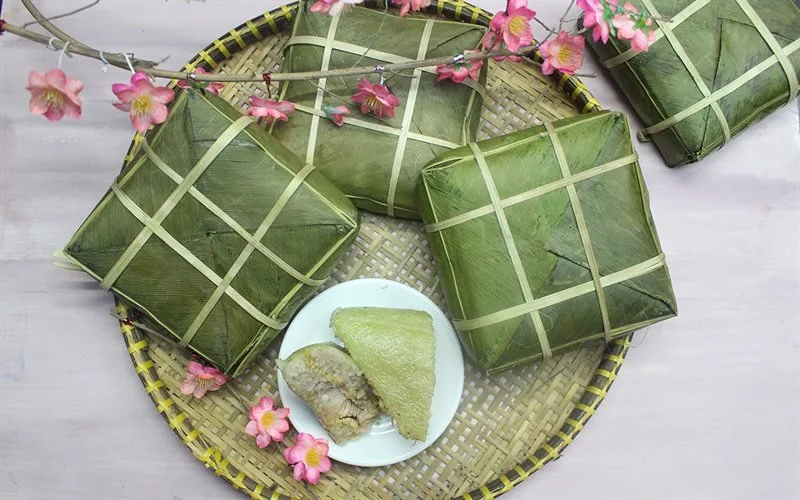

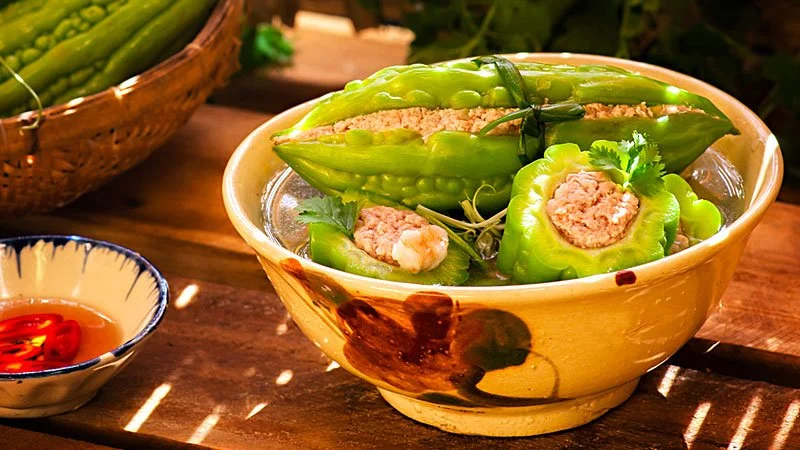
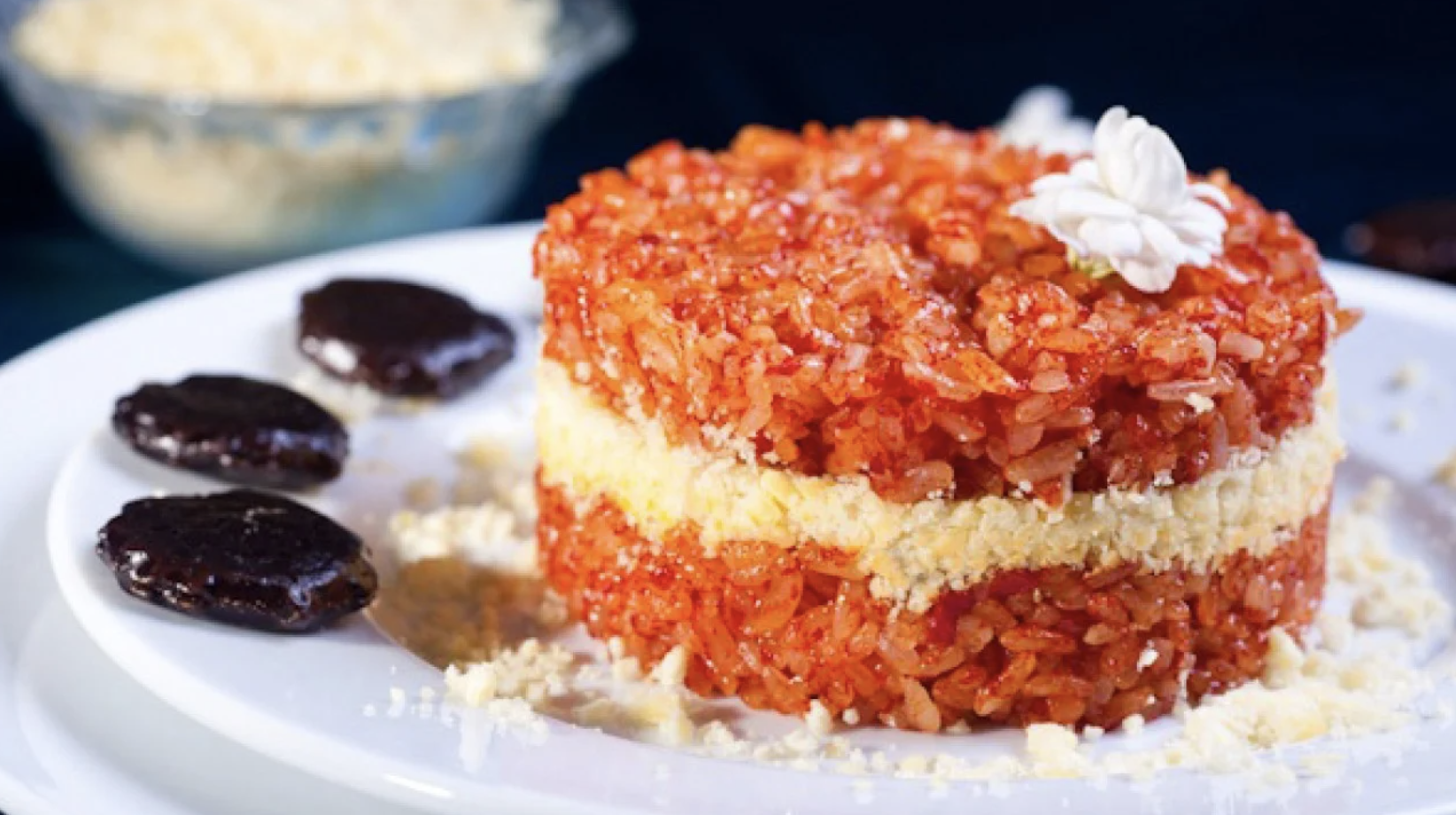
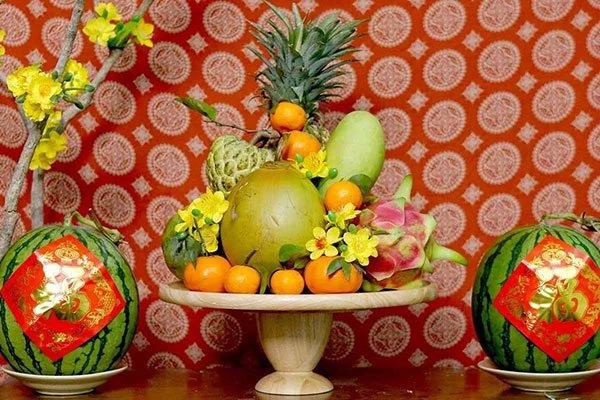
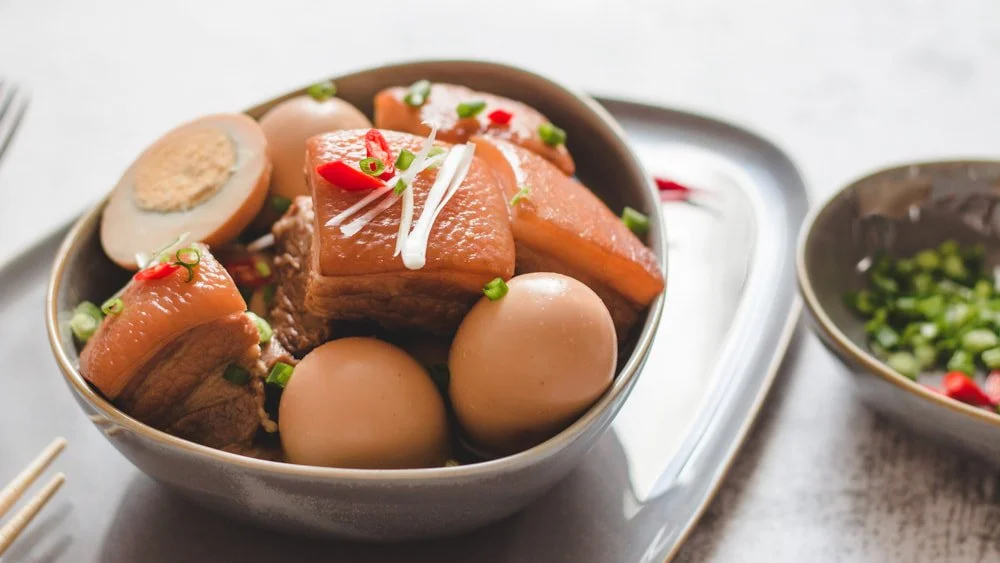
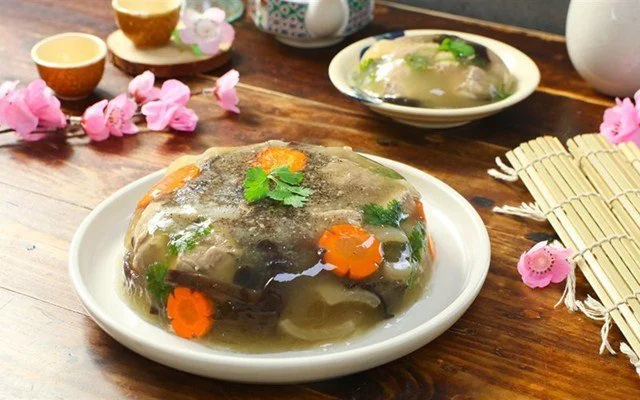




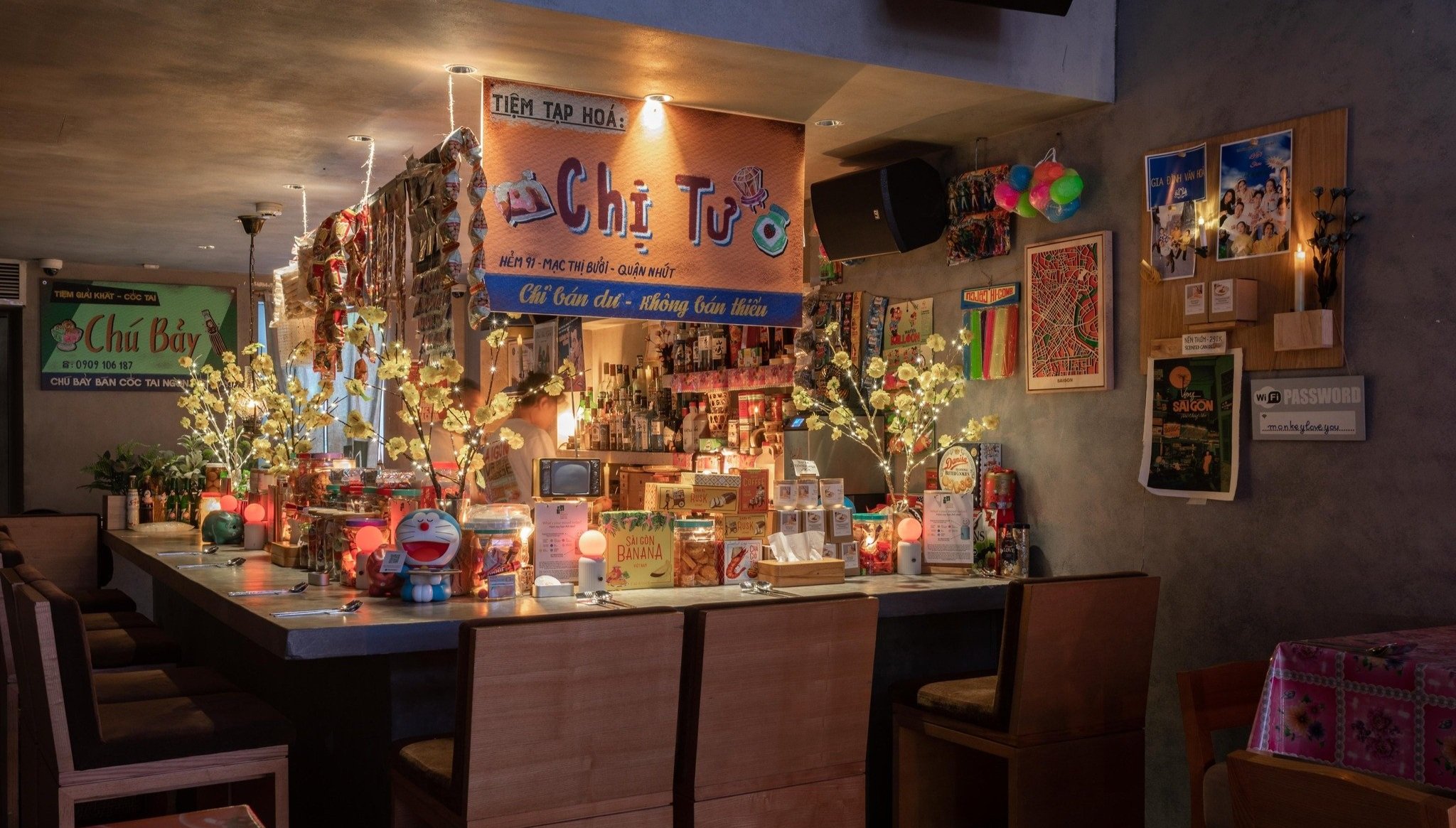











Like what you read?
Discover Vietnam’s coming-of-age food and drink scene with one of our tours and experiences exclusively available at Saigon Social